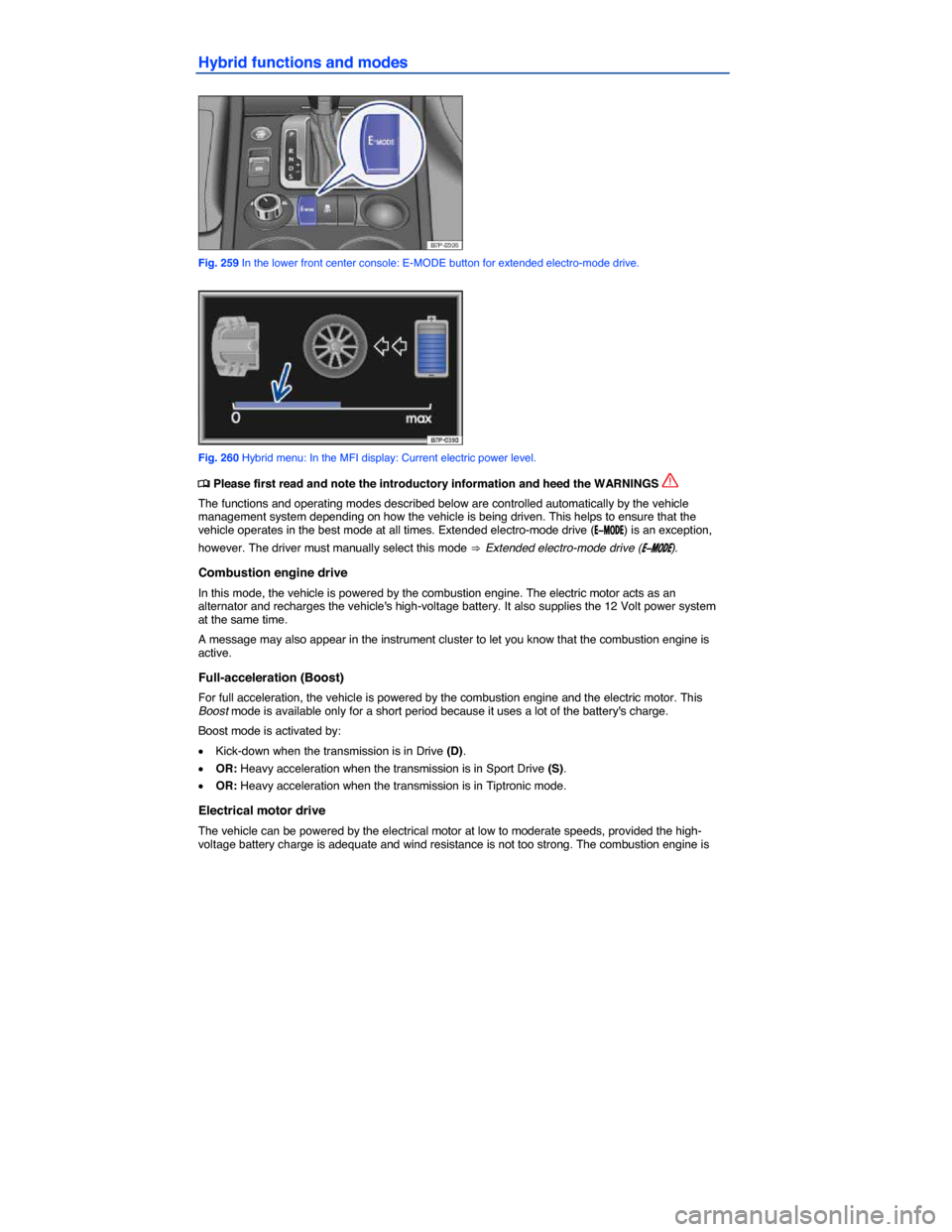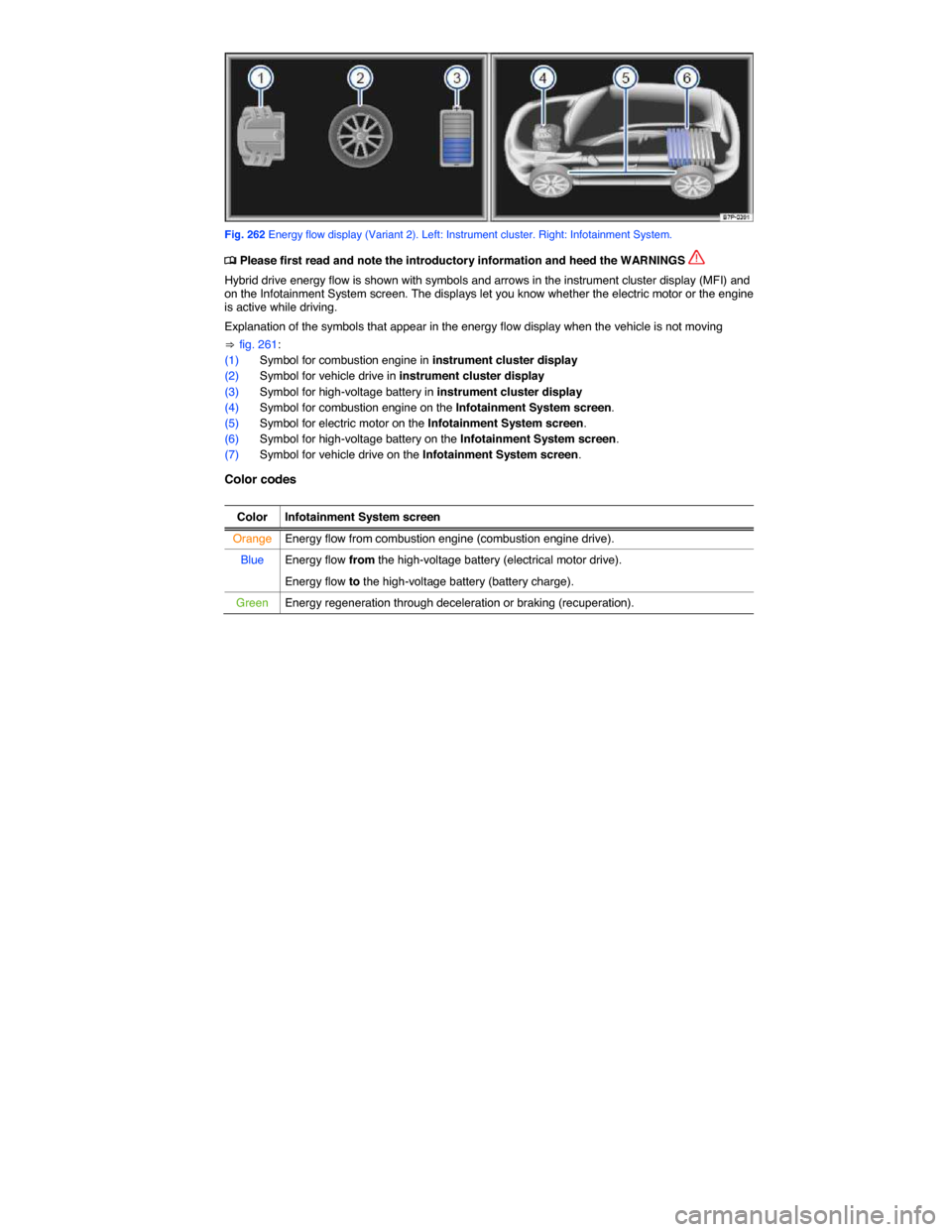2014 VOLKSWAGEN TOUAREG display
[x] Cancel search: displayPage 370 of 620

Ignition switched on, engine is started. Diesel engine is preheated. vehicle key cannot be removed from ignition switch.
On Hybrid vehicles depending on the environmental conditions and the current operating state of the vehicle, either the combustion engine will be started or pure electric departure will be enabled. This leaves the combustion engine off for the time being. In both cases, the vehicle �2�%�!�$�9 indicator will be displayed in the instrument cluster
To stop the engine, again turn the vehicle key to the left or right and release. vehicle key can then be removed from ignition switch.
To switch off the engine, turn the vehicle key either clockwise or counterclockwise and release. The vehicle key can be removed from the ignition switch when the transmission shift lever is in the (P) position.
If you use the wrong key
If an unauthorized remote control vehicle key has been inserted into the ignition switch, it can be removed as follows:
�x The vehicle key cannot be removed from the ignition unless both the key and the selector lever have been moved to the correct position. Press the release button on the transmission selector lever, move the selector lever to the Park (P) position and release the button. The vehicle key can now be removed.
WARNING
Improper use of vehicle keys can result in serious personal injury.
�x Always take the key with you when you leave the vehicle. The engine can be started and vehicle systems such as the power windows can be operated, leading to serious personal injury.
�x Never leave children, disabled persons, or anyone who cannot help themselves in the vehicle. The doors can be locked with the remote control vehicle key. This could result in people being trapped in the vehicle in an emergency. For example, depending on the time of year, people trapped in the vehicle can be exposed to very high or very low temperatures.
�x Heat build-up in the passenger and luggage compartment of a parked vehicle can result in temperatures in the vehicle that are much higher than the outside temperatures, particularly in summer. Temperatures can quickly reach levels that can cause unconsciousness and death, particularly to small children.
�x Never remove the key from the ignition switch while the vehicle is moving or rolling to a stop. The steering wheel will lock and you will not be able to steer or control the vehicle.
Leaving the key in the ignition for a long time when the engine is not running will drain the vehicle battery.
Leaving the selector lever for a long period of time in any position other than Park (P) when the ignition is switched off can drain the vehicle battery.
The vehicle key can be removed from the ignition switch only when the transmission is in Park (P). You may have to press the release button on the transmission selector lever to put the lever into Park (P).
Page 391 of 620

Brake system malfunction
If you brake and find that vehicle doesn't brake nearly as well as it used to (sudden increase in stopping distance), a brake circuit may have failed. The brake warning light �"�2�!�+�% or �H will come on and a message may appear in the instrument cluster display. If you believe the vehicle is safe to drive, immediately take it to the nearest authorized Volkswagen dealer or authorized Volkswagen Service Facility for repair. Drive slowly and very carefully, allow for the longer stopping distance, and be ready to push longer and harder on the brake pedal to slow the vehicle down.
Brake booster
The brake booster works only when the engine is running. It increases the force on the brakes above and beyond the pressure put on the brake pedal by the driver.
If the brake booster is not working, or if the vehicle has to be towed, you will have to push the brake pedal harder to make up for the lack of booster assistance and the resulting longer stopping distance
⇒ .
WARNING
New brake pads do not provide maximum braking performance.
�x New brake pads do not have the best stopping power for the first 200 miles (320 km) and must be “broken in.” You can compensate for the slightly reduced braking force by putting more pressure on the brake pedal.
�x Drive with extra care while the new brake pads are being broken in. This reduces the risk of collisions and serious personal injuries due to a loss of control over the vehicle.
�x Never follow other vehicles too closely or put yourself into other situations that might require sudden, hard braking, especially when the brake pads have not been broken in.
WARNING
Overheated brakes will reduce the vehicle's stopping power and increase stopping distances considerably.
�x When driving downhill, the brakes have to work especially hard and heat up quickly.
�x Before driving downhill, especially on hills that are long or steep, always reduce speed and shift into lower gear (manual or automatic transmission). This will let the vehicle use engine braking and reduce the load on the brakes. Otherwise, the brake system could overheat and possibly fail. Only use the brakes when you need them to slow the vehicle down more or to stop.
�x A damaged front spoiler or a non-standard spoiler can reduce airflow to the brakes and make them overheat.
WARNING
Wet brakes or brakes coated with ice or road salt react slower and need longer stopping distances.
�x Carefully apply the brakes to test them.
�x Always dry brakes and clean off ice and salt coatings with a few cautious brake applications when visibility, weather, road and traffic conditions permit.
Page 405 of 620

DANGER
The vehicle's high-voltage electrical system and high-voltage battery are dangerous and can cause burns, other serious personal injuries, electrocution, and death.
�x Always assume that high-voltage battery and parts of the high-voltage system are fully charged and energized.
�x Never touch or let jewelry or other metal objects contact high-voltage cables or the high-voltage battery and battery poles, especially if the cables, battery, and battery poles have been damaged in any way.
�x Never do any work yourself on the high-voltage electrical system, the orange-colored high-voltage wiring, or on the high-voltage battery.
�x Never open, service, repair, or disconnect any part of the hybrid electrical system.
�x Never damage the orange-colored high-voltage cables. Never remove them and never disconnect them from the high-voltage electrical system.
�x Never open or remove the orange-colored cover on the high-voltage battery.
�x Always have work on the hybrid electrical system and systems that could be indirectly affected by it done by qualified, trained technicians who have the know-how, experience, documentation, and tools to do the work safely.
�x All work on the high-voltage electrical system and the high-voltage battery must be done in compliance with Volkswagen standards and guidelines.
�x Vehicle keys must be safely stored a safe distance from vehicle so that the ignition cannot be switched on and energize the electrical system.
�x Gases vented or released from the high-voltage battery vapors are potentially poisonous and can burn.
�x Physical damage to the vehicle or the high-voltage battery can result in immediate or delayed release of poisonous gases that can also cause a fire.
�x Always avoid contact with leaking fluids and gases escaping from the battery, particularly one that has been damaged.
�x Always tell emergency responders that the vehicle has a high-voltage battery.
WARNING
Driver distraction causes accidents and serious personal injury. Using the instrument cluster or accessing Infotainment System menus while driving can take your attention off the road and cause accidents.
�x To help reduce the risk of accidents and injuries, never change settings in the instrument cluster display or use Infotainment System functions unless the vehicle is standing still.
Page 407 of 620

Warning messages
When the ignition is switched on, several warning and indicator lights come on briefly for a function check. They go out after a few seconds.
Warning lights and text messages are shown in the instrument cluster display. Acoustic warnings may also sound at the same time.
Lights up Warnings in the instrument cluster display Proper response
∋ Fault in the hybrid system: stop the vehicle at a safe location! Stop the vehicle in a safe place as soon as it is safe to do so.
∋
Fault in the hybrid system: Workshop! See an authorized Volkswagen dealer or an authorized Volkswagen Service Facility.
Hybrid battery is charging, leave engine running. While this message appears, do not stop the engine.
�2�%�!�$�9 Electric drive is READY.
Never leave the vehicle parked in the ready position. Remove the remote control vehicle key out of the ignition or for vehicle with Keyless Access press the starter button. When leaving the vehicle always take the remote control vehicle key with you.
�%�
Page 410 of 620

Hybrid functions and modes
Fig. 259 In the lower front center console: E-MODE button for extended electro-mode drive.
Fig. 260 Hybrid menu: In the MFI display: Current electric power level.
�
Page 411 of 620

switched of in this mode. Gentle start-ups (getting the vehicle going) and parking are also phases the electrical motor can often handle alone.
The combustion engine is started if you accelerate faster or if the charge level of the high-voltage battery gets too low. As soon as allowed by your acceleration and the high-voltage battery charge level, the vehicle switches back to electrical motor drive.
Use the following indicators to tell when the vehicle is being powered electrically:
�x Tachometer for the combustion engine shows zero engine revolutions.
�x Instrument cluster display.
�x Infotainment System screen.
Extended electro-mode drive (�%�
Page 412 of 620

necessary for the system to start the combustion engine even when the vehicle is not moving. With prolonged driving in traffic jams, the combustion engine will be switched on and off to charge the high-voltage battery for the following start-stop phase.
Sailing
If the accelerator is not depressed and the lever is in Drive (D), the internal combustion engine is switched off even at higher speeds. The vehicle then decelerates slower than conventional vehicles.
This feature can be used to help reduce fuel consumption when you keep traffic conditions in mind and can anticipate the vehicles power requirements. Even in this case, the rev counter in the instrument cluster displays zero engine speed (0 engine revolutions). The instrument cluster powermeter shows zero.
Brake energy regeneration (Recuperation/charge)
When the vehicle brakes, the electrical energy is generated by the electric motor, which works as an alternator and charges the high-voltage battery. The same thing occurs while the vehicle is coasting to a stop or driving downhill.
Energy regeneration is shown in the instrument cluster display or on the Infotainment System screen. The combustion engine may be switched off automatically in this situation. The instrument cluster tachometer will show zero engine speed (zero engine revolutions). The instrument cluster powermeter shows zero.
Automatic starting - combustion engine
The combustion engine is started automatically in a number of situations.
�x Engine temperature is too low.
�x Catalytic converter temperature is too low.
�x High-voltage battery being charged at high rate when decelerating. The high-voltage battery cannot absorb any more energy and for this reason the electric motor cannot brake the vehicle. The combustion engine comes on to help slow the vehicle down (engine brake).
�x Engine hood is open.
�x Leaving the vehicle when the electric motor is still “live”. The status of the electric motor is not always obvious, particularly when the combustion engine is not running. The combustion engine will therefore start if the driver's safety belt is unlatched or the driver's door is opened when the
transmission is in Park (P) or Neutral (N) ⇒ Warning when leaving the vehicle.
Energy flow display
Fig. 261 Energy flow display (Variant 1). Left: Instrument cluster. Right: Infotainment System.
Page 413 of 620

Fig. 262 Energy flow display (Variant 2). Left: Instrument cluster. Right: Infotainment System.
�